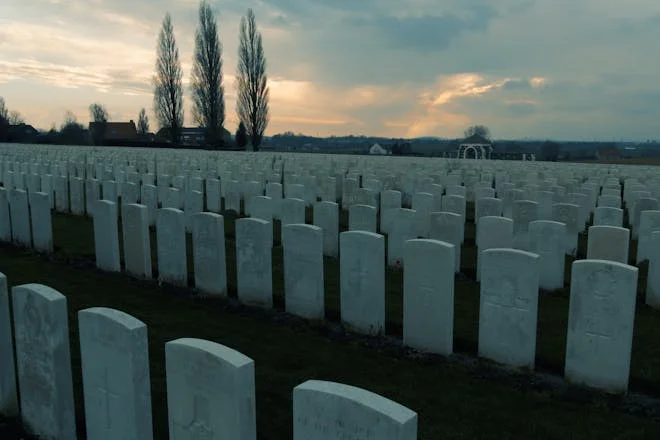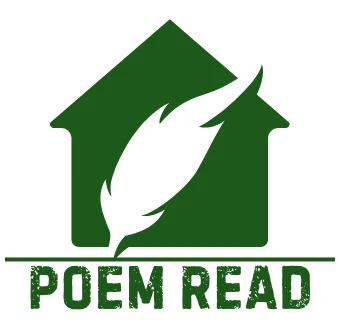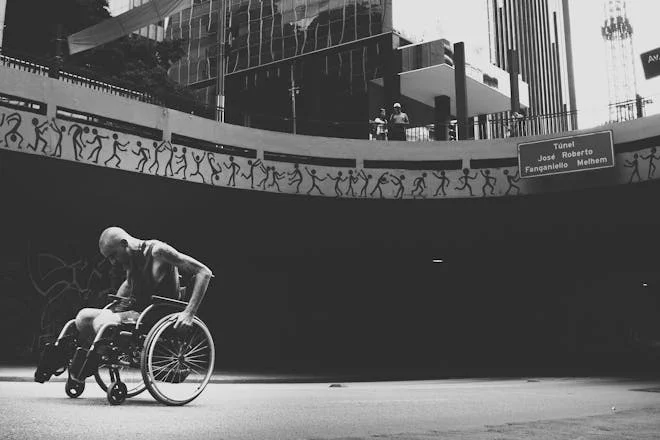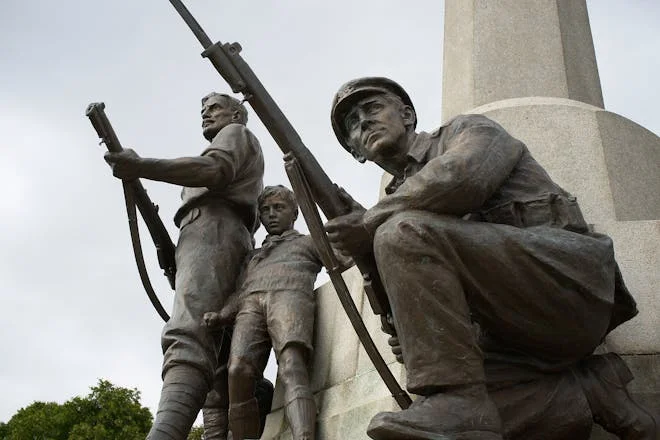
Let’s take a closer look at “Dulce et Decorum Est,” an emotionally charged poem by Wilfred Owen. In this exploration, we unravel the layers of Owen’s anti-war sentiment, vivid imagery, and powerful message. Through gripping descriptions and emotional resonance, Owen challenges the glorification of war, exposing its harsh realities and the toll it takes on soldiers. Join us as we analyze the themes, structure, and literary devices used in this timeless piece of literature.
Dulce et Decorum Est BY WILFRED OWEN Bent double, like old beggars under sacks, Knock-kneed, coughing like hags, we cursed through sludge, Till on the haunting flares we turned our backs, And towards our distant rest began to trudge. Men marched asleep. Many had lost their boots, But limped on, blood-shod. All went lame; all blind; Drunk with fatigue; deaf even to the hoots Of gas-shells dropping softly behind. Gas! GAS! Quick, boys!—An ecstasy of fumbling Fitting the clumsy helmets just in time, But someone still was yelling out and stumbling And flound’ring like a man in fire or lime.— Dim through the misty panes and thick green light, As under a green sea, I saw him drowning. In all my dreams before my helpless sight, He plunges at me, guttering, choking, drowning. If in some smothering dreams, you too could pace Behind the wagon that we flung him in, And watch the white eyes writhing in his face, His hanging face, like a devil’s sick of sin; If you could hear, at every jolt, the blood Come gargling from the froth-corrupted lungs, Obscene as cancer, bitter as the cud Of vile, incurable sores on innocent tongues,— My friend, you would not tell with such high zest To children ardent for some desperate glory, The old Lie: Dulce et decorum est Pro patria mori.
Content
- About the Author: Wilfred Owen
- Subject of "Dulce et Decorum Est"
- Context of "Dulce et Decorum Est"
- Theme and Tone of "Dulce et Decorum Est"
- The Form and Structure of "Dulce et Decorum Est"
- Line-by-Line Analysis of "Dulce et Decorum Est"
- Poetic and Literary Devices of "Dulce et Decorum Est"
- Implications and Meanings of "Dulce et Decorum Est"
- Interactive Summary of "Dulce et Decorum Est"
About the Author: Wilfred Owen
Wilfred Owen’s journey as a soldier began in 1915, when he enlisted in the British Army with optimism and eagerness to serve his country. However, witnessing the brutalities of war firsthand on the Western Front quickly turned his enthusiasm into disillusionment. The relentless shelling, constant fear of death, and devastating gas attacks he experienced deeply influenced Owen’s poetry, which became a powerful medium for expressing his anti-war sentiments.
His notable works like “Dulce et Decorum Est” and “Anthem for Doomed Youth” vividly depict the pain and suffering of soldiers, contrasting the patriotic propaganda with the grim reality of war. Owen’s writing style, which drew inspiration from Romantic poets like Keats and Shelley, incorporated themes of nature and life’s fragility, showcasing both darkness and moments of beauty and tenderness.
Tragically, Owen’s promising career was cut short when he was at the age of 25. Despite his untimely death, Owen’s poetry continues to be celebrated for its raw honesty, immortalizing the experiences of soldiers and serving as a reminder of the sacrifices and consequences of armed conflict.
Subject of “Dulce et Decorum Est”
The poem “Dulce et Decorum Est” by Wilfred Owen explores the harsh realities and devastating effects of war, specifically focusing on the experiences of soldiers fighting in World War I. The poem extensively describes the physical and mental toll that war takes on the soldiers, highlighting the pain, suffering, and disillusionment they endure.
Description of Soldiers’ Experiences
In the opening lines of the poem, Owen sets the tone by describing the soldiers as “bent double, like old beggars under sacks.” This image immediately conveys the physical exhaustion and degradation that the soldiers face on a daily basis. The use of simile emphasizes the stark contrast between the idealized notions of war and the grim reality that the soldiers face.
Depiction of Horrors of War
As the poem progresses, Owen takes the reader into the heart of the battlefield, painting a vivid picture of the horrors of war. He describes a gas attack, recounting the panic and chaos that ensue as the soldiers scramble to put on their gas masks.
The use of vivid imagery, such as “flound’ring like a man in fire or lime” and “guttering, choking, drowning,” evokes a sense of suffocation and helplessness. Through these powerful descriptions, Owen exposes the true nature of war—a brutal and dehumanizing experience that strips away the soldiers’ dignity and humanity.
Irony and Criticism of Patriotism
Furthermore, Owen challenges the notion of war as something noble and honorable. The Latin phrase “Dulce et decorum est pro patria mori,” which translates to “It is sweet and honorable to die for one’s country,” is used ironically throughout the poem. Owen mocks the romanticized idea of war by depicting the gruesome reality that the soldiers face. He exposes the falsehood of patriotic propaganda and highlights the hypocrisy of those who glorify war without experiencing its true horrors.
Direct Address to the Reader
In the final stanza of the poem, Owen directly addresses the reader, urging them to confront the harsh truth about war. He implores the reader to “watch the white eyes writhing in his face” and to “smothering dreams” of war’s glory. By involving the reader in this way, Owen forces them to confront their own complicity in perpetuating the myth of war as something noble and honorable.
In summary, “Dulce et Decorum Est” by Wilfred Owen is a powerful and moving poem that exposes the harsh realities and devastating effects of war. Through vivid imagery and irony, Owen challenges the romanticized notions of war and forces the reader to confront the true horror and futility of armed conflict. This poem serves as a stark reminder of the sacrifices made by soldiers and the urgent need to work towards a world free from the ravages of war.
Context of “Dulce et Decorum Est”
“Dulce et Decorum Est” was written in 1917 during World War I, a time when war propaganda often glorified the idea of sacrificing one’s life for their country. Owen, who had firsthand experience with the horrors of war, sought to refute and expose the romanticized ideas about war that society upholds. The poem was published posthumously in 1920, two years after Owen’s death in battle.
Society’s Romanticized View of War
During World War I, many people believed that going to war was a noble and heroic act. Propaganda posters and patriotic speeches portrayed soldiers as brave and selfless individuals who were willing to lay down their lives for their country. This sentiment was captured in the Latin phrase “Dulce et decorum est pro patria mori,” which translates to “It is sweet and honorable to die for one’s country.” This phrase was often used to justify the sacrifice of soldiers and encourage others to enlist.
Owen’s Harrowing Experiences
However, Owen’s experiences on the front lines of the war shattered this romanticized view of war. He witnessed the horrors of trench warfare, the devastating effects of gas attacks, and the physical and psychological toll it took on the soldiers. Owen himself suffered from shell shock and was sent to a hospital to recover. It was during this time that he wrote “Dulce et Decorum Est” as a response to the propaganda that he believed misled young men into enlisting.
Description of War’s Reality in the Poem
In the poem, Owen describes the gruesome reality of war. He depicts a group of soldiers trudging through mud and gas-filled trenches, exhausted and in a constant state of fear. Suddenly, there is a gas attack, and one soldier fails to put on his gas mask in time.
Owen describes the agonizing death of this soldier, as he chokes and suffocates from the poisonous gas. The poem ends with a powerful plea to the reader, urging them to reconsider the glorification of war and the notion that it is honorable to die for one’s country.
Impact and Legacy
The publication of “Dulce et Decorum Est” after Owen’s death had a powerful impact on the perception of war. It exposed the harsh realities of combat and challenged the prevailing narrative of heroism and sacrifice. Owen’s poem developed into a potent anti-war statement that called into question the glorification of war and highlighted the psychological and physical trauma that soldiers go through. It served as a wake-up call to society, forcing them to confront the true cost of war and the need for peace.
Owen’s legacy as a war poet continues to resonate today. His powerful and poignant poetry has become synonymous with the horrors of war and the futility of violence. “Dulce et Decorum Est” remains a timeless reminder of the human toll of war and the importance of understanding the true consequences of conflict.
Theme and Tone of “Dulce et Decorum Est”

Theme: War’s Futility and Brutality
The theme of “Dulce et Decorum Est” revolves around the idea that war is not glorious or honorable but rather a futile and brutal endeavor that inflicts immense suffering on those involved. Wilfred Owen emphasizes this theme through vivid and disturbing imagery, highlighting the physical and mental trauma experienced by soldiers.
Opening Imagery: Despair and Grim Realities
The poem opens with vivid imagery depicting soldiers trudging through mud with “blood-shod” feet and “knock-kneed” postures, “coughing like hags.” This imagery immediately sets a tone of despair and paints a grim picture of the soldiers’ deteriorating condition, setting the stage for the theme of war’s brutality.
Gas Attack: Terror and Chaos
As the poem progresses, Owen describes a gas attack that captures the terror and chaos of the moment. Soldiers scramble to put on gas masks, but one fails and suffers a slow, agonizing death. Graphic imagery like “white eyes writhing in his face” shocks and disturbs the reader, reinforcing the senseless brutality of war and the theme of its futility.
Tone: Somber, Disillusioned, and Bitter
The poem’s tone is somber, disillusioned, and bitter, reflecting Owen’s anti-war sentiments. He challenges the idea of dying for one’s country as sweet and honorable, instead portraying it as a lie perpetuated by those who have not faced war’s horrors firsthand. The tone reinforces the theme of war’s brutality and the need to confront its realities.
Direct Address to the Reader: Confronting the Reality of War
The poem concludes with a direct address to the reader, urging them to confront the reality of war and reject its glorification. Owen’s intention is to awaken the reader to the true horrors of combat and to inspire a reevaluation of the romanticized notions surrounding war.
In summary, “Dulce et Decorum Est” is a powerful anti-war poem that explores the theme of war’s futility and brutality through vivid imagery and a somber, disillusioned tone. Owen challenges the glorification of war and calls for a deeper understanding of its devastating effects on those who experience it firsthand.
The Form and Structure of “Dulce et Decorum Est”
Combination of Two Sonnets
“Dulce et Decorum Est” by Wilfred Owen defies traditional poetic structures by combining two sonnets into one cohesive composition. A break comes after the first 12 lines of one sonnet, and then another sonnet with 12 lines follows. Although the spacing between them is regular, the overall effect resembles that of a French ballad. The irregular breaks between the sonnets emphasize the imperfectness of the world portrayed in the poem.
This unconventional structure adds depth and complexity to the poem, allowing Owen to explore different facets of the war experience. The break between the sonnets serves as a moment of reflection for readers, emphasizing the contrast between the romanticized ideals of war and the harsh realities depicted in the poem.
Stanza Structure and Progression
The poem is divided into four stanzas, each serving a distinct purpose in conveying Owen’s anti-war message. The first stanza sets the scene and introduces the physical condition of the soldiers, describing them as “Bent double, like old beggars under sacks.” This vivid imagery immediately immerses readers in the grim reality of war.
The second stanza abruptly shifts in tone as Owen vividly describes a gas attack, utilizing urgent phrases like “Gas! GAS! Quick, boys!” to depict the chaos and horror of warfare. The third stanza focuses on the aftermath of the gas attack, highlighting the suffering and death caused by such atrocities. Finally, the fourth stanza delivers a powerful condemnation of the glorification of war and the false ideals of honor and sacrifice.
Use of Imagery and Enjambment
Owen’s skillful use of imagery and enjambment adds depth and intensity to “Dulce et Decorum Est.” Enjambment, the continuation of a sentence beyond the end of a line, creates a sense of urgency and fluidity in the poem. It mirrors the relentless march of soldiers and the chaotic nature of war, drawing readers into the harrowing experiences described. The vivid imagery employed throughout the poem, such as “blood-shod,” “white eyes writhing,” and “froth-corrupted lungs,” evokes visceral reactions and reinforces the brutality of war, leaving a lasting impact on readers.
Rhyme and Meter
While “Dulce et Decorum Est” does not adhere to a strict rhyme scheme, Owen strategically uses occasional rhymes to enhance certain lines and create a rhythmic flow. The meter varies throughout the poem, contributing to its natural and conversational tone while also intensifying the emotional impact of specific lines. This deviation from traditional rhyme and meter adds to the poem’s raw and authentic portrayal of war, capturing the chaotic and unpredictable nature of the battlefield.
Impact on Readers and Literary Legacy
The form and structure of “Dulce et Decorum Est” significantly contribute to its emotional impact on readers. The fragmented lines, irregular breaks, and powerful imagery work together to convey Owen’s anti-war message with poignancy and depth. This poem continues to resonate with audiences, serving as a timeless reminder of the human cost of conflict and the urgent need for peace. Wilfred Owen’s innovative approach to form and structure in “Dulce et Decorum Est” has cemented its place as a classic anti-war poem that continues to inspire reflection and critical discourse on the realities of war.
Line-by-Line Analysis of “Dulce et Decorum Est”
Stanza One: Setting the Scene
The poem opens by describing soldiers who are physically worn out and downtrodden. Owen compares them to “old beggars under sacks,” highlighting their fatigue and hardship. This imagery immediately introduces readers to the harsh conditions of war, where soldiers endure exhaustion and discomfort as they navigate through the trenches.
Bent double, like old beggars under sacks,
The opening line sets a tone of weariness and degradation. The soldiers are portrayed as bent over, resembling old beggars burdened by heavy sacks. This imagery immediately conveys the physical toll and exhaustion of war.
Knock-kneed, coughing like hags, we cursed through sludge,
The second line further emphasizes the soldiers’ physical state, highlighting their weakened knees and persistent coughing. The comparison to hags adds a sense of weakness and suffering. The soldiers are shown navigating through difficult terrain, cursing their way through the mud.
Till on the haunting flares we turned our backs,
This line introduces the element of danger with “haunting flares,” indicating enemy activity. The soldiers instinctively turn away from these flares, suggesting a constant threat and the need for vigilance.
And towards our distant rest began to trudge.
Despite their exhaustion and the looming danger, the soldiers press on toward a distant place of rest. The word “trudge” implies a slow and laborious journey, underscoring the hardship they endure.
Men marched asleep. Many had lost their boots,
The following lines depict the extreme fatigue of the soldiers, who are so exhausted that they appear to be marching in their sleep. The mention of lost boots adds to the image of their disarray and deprivation.
But limped on, blood-shod. All went lame; all blind;
These lines intensify the imagery of physical suffering. The soldiers continue to move forward despite being “blood-shod,” indicating their injured and bloody feet. The repetition of “all” emphasizes the widespread impact of the war, with everyone affected by injury and blindness.
Drunk with fatigue; deaf even to the hoots
The soldiers are described as “drunk with fatigue,” highlighting the overwhelming exhaustion they face. They are so fatigued that they become deaf to external sounds, such as the hoots of approaching gas shells.
Of gas-shells dropping softly behind.
The line suggests the constant threat of gas attacks, with shells dropping quietly in the background. This subtle yet menacing imagery adds to the atmosphere of danger and unpredictability.
Stanza Two: The Gas Attack
In the second stanza, Owen vividly portrays a gas attack during wartime. The tone becomes urgent as he exclaims, “Gas! GAS! Quick, boys!” This abrupt shift in atmosphere captures the suddenness and chaos of such an attack. Readers are plunged into the frantic and terrifying moments when soldiers scramble to protect themselves from deadly gas, showcasing the relentless danger faced on the battlefield.
Gas! GAS! Quick, boys!—An ecstasy of fumbling
The sudden cry of “Gas! GAS!” creates a sense of panic and urgency. The soldiers scramble to put on their gas masks in a chaotic and frantic manner, described as an “ecstasy of fumbling,” highlighting the desperate struggle to protect themselves.
Fitting the clumsy helmets just in time,
The soldiers manage to put on their gas masks at the last moment, underscoring the narrow margin between life and death on the battlefield.
But someone still was yelling out and stumbling
Despite their efforts, there is a sense of helplessness as someone continues to yell and stumble, unable to protect themselves adequately.
And flound’ring like a man in fire or lime.—
The imagery of someone “flound’ring like a man in fire or lime” evokes a vivid and agonizing picture of someone in distress, struggling and suffering.
Dim through the misty panes and thick green light,
The scene transitions to a misty and eerie atmosphere, with the soldiers’ vision obscured by gas and smoke.
As under a green sea, I saw him drowning.
The comparison to a “green sea” further enhances the suffocating and overwhelming nature of the gas attack. The speaker describes witnessing someone drowning in the gas, helpless to save them.
Stanza Three: Aftermath of Horror
Following the gas attack, the third stanza delves into its aftermath. Owen paints a haunting picture of a soldier struggling in agony, likening him to someone “flound’ring like a man in fire or lime.” This vivid imagery conveys the horrific suffering and helplessness experienced by victims of gas attacks. The descriptions of physical trauma and suffocation provide a stark portrayal of the brutal realities of warfare.
In all my dreams before my helpless sight,
The speaker reflects on the haunting impact of the gas attack, which continues to haunt them even in dreams.
He plunges at me, guttering, choking, drowning.
The image of the drowning soldier is vividly described, emphasizing their agony and imminent death.
Stanza Four: Condemnation and Plea
The final stanza delivers a powerful condemnation of war’s glorification and the false notions of honor associated with it. Owen directly addresses the reader, exposing the lie that it is “sweet and proper to die for one’s country” (translated from Latin). He challenges the romanticized ideals of war and urges readers to reconsider their beliefs about its supposed glory. This stanza serves as a genuine plea for truth and recognition of the true costs of conflict.
If in some smothering dreams, you too could pace
The speaker invites the reader to imagine experiencing the suffocating horrors of war in their dreams.
Behind the wagon that we flung him in,
The image of throwing a wounded soldier into a wagon suggests the harsh and impersonal treatment of casualties in war.
And watch the white eyes writhing in his face,
The description of the soldier’s “white eyes writhing” adds to the graphic and disturbing imagery of suffering and death.
His hanging face, like a devil’s sick of sin;
The comparison of the soldier’s face to a devil’s sick of sin conveys a sense of grotesque and unnatural suffering.
If you could hear, at every jolt, the blood
The speaker continues to describe the visceral and gruesome realities of transporting wounded soldiers, with blood gurgling and splattering with each movement.
Come gargling from the froth-corrupted lungs,
The description of blood gargling from corrupted lungs adds to the horrific and disturbing imagery.
Obscene as cancer, bitter as the cud
The comparison of the blood and injuries to cancer and bitter cud emphasizes the repulsive and devastating nature of battle wounds.
Of vile, incurable sores on innocent tongues,—
The imagery of incurable sores on innocent tongues underscores the senseless suffering and damage caused by war.
My friend, you would not tell with such high zest
The speaker addresses the reader directly, questioning their enthusiasm and glorification of war.
To children ardent for some desperate glory,
The mention of children eager for glory highlights the danger of perpetuating false ideals about war to future generations.
The old Lie: Dulce et decorum est
The poem concludes with a powerful condemnation of the idea that it is sweet and honorable to die for one’s country. The phrase “Dulce et decorum est pro patria mori” (translated as “It is sweet and honorable to die for one’s country”) is labeled as “the old Lie,” challenging the false glorification of war and sacrifice.
Overall Impact and Themes
Through its detailed imagery and shifting tones, “Dulce et Decorum Est” effectively conveys the harsh realities and devastation of war. Each stanza contributes to the poem’s overall theme of disillusionment with war’s glorification. The vivid descriptions and direct language create a powerful emotional impact, leaving readers with a profound understanding of the physical and psychological tolls of armed conflict. Owen’s message, challenging the notions of honor and sacrifice in war, resonates as a timeless anti-war sentiment that continues to hold significance today.
Poetic and Literary Devices of “Dulce et Decorum Est”

Wilfred Owen’s “Dulce et Decorum Est” is a masterful display of poetic and literary devices that enhance the impact of his anti-war message. Let’s examine some of these devices and their significance in the poem:
Imagery
The poem opens with vivid imagery, describing the soldiers as “Bent double, like old beggars under sacks” and “Knock-kneed, coughing like hags.” This imagery immediately sets a grim tone, conveying the physical toll of war and the soldiers’ degraded state.
Metaphor
Owen employs metaphors to convey the dehumanizing effects of war. For instance, he describes the soldiers as “drunk with fatigue” and “deaf even to the hoots / Of tired, outstripped Five-Nines.” These metaphors emphasize the soldiers’ exhaustion and desensitization to the dangers around them.
Simile
The comparison of soldiers to “old beggars under sacks” and “coughing like hags” through similes highlights their degradation and suffering, painting a vivid picture of their plight.
Alliteration
Owen uses alliteration to create rhythm and emphasis. For example, phrases like “blood-shod,” “flound’ring like a man,” and “froth-corrupted lungs” not only enhance the auditory experience but also intensify the imagery.
Repetition
The repetition of “Gas! GAS! Quick, boys!” conveys the urgency and panic during a gas attack, immersing the reader in the chaos of the moment.
Irony
The poem is steeped in irony, particularly in its title and concluding lines. Owen challenges the notion that it is honorable to die for one’s country, labeling it as “the old lie.” This ironic twist exposes the falsehood of patriotic propaganda.
Enjambment
Owen’s use of enjambment creates a flowing rhythm, mirroring the relentless march of the soldiers and the chaotic nature of war. This technique adds to the urgency and emotional impact of the poem.
Juxtaposition
The contrast between the graphic imagery of war and the idealized notions of heroism and patriotism creates a stark juxtaposition. Owen juxtaposes the gruesome image of a dying soldier with distant “haunting flares,” highlighting the stark contrast between reality and perception.
Sensory Imagery
Owen incorporates sensory imagery, such as “thick green light” and “white eyes writhing,” to evoke a visceral response from the reader. These descriptions appeal to the senses, intensifying the emotional and visual impact of the poem.
Personal Experience
Owen’s personal experience as a soldier adds authenticity and depth to the poem. His firsthand knowledge of war’s horrors lends credibility to his critique and invites readers to empathize with the soldiers’ experiences.
Overall, Wilfred Owen’s use of poetic and literary devices in “Dulce et Decorum Est” amplifies the emotional resonance of his anti-war message, challenging romanticized notions of war and urging readers to confront its harsh realities.
Implications and Meanings of “Dulce et Decorum Est”
The implications and meanings of Wilfred Owen’s “Dulce et Decorum Est” delve deep into the harsh realities of war and the hypocrisy of glorifying it. Let’s explore the profound implications and overarching meaning of this anti-war poem:
Exposing the Horrors of War
The poem serves as a stark reminder of the brutal and dehumanizing nature of war. Through vivid imagery and graphic descriptions, Owen portrays the physical and psychological toll that soldiers endure on the battlefield. The poem’s detailed accounts of gas attacks, injuries, and suffering expose the inhumanity and senseless violence inherent in armed conflict.
Challenging Romanticized Notions
Owen’s use of irony is central to the poem’s meaning. The title, “Dulce et Decorum Est,” which translates to “It is sweet and honorable,” is followed by the assertion that it is a lie. This challenges the traditional narrative that dying for one’s country is noble and glorious. Owen exposes the falsehood of patriotic propaganda and critiques those who perpetuate the myth of war’s honor without experiencing its true horrors.
Condemning War Propaganda
The poem condemns the manipulation of young minds with false ideals of heroism and sacrifice. Owen directly addresses the reader, particularly those who propagate the glorification of war, cautioning against the dangers of instilling false notions of glory in the minds of impressionable youth. He warns against the allure of patriotic fervor that blinds individuals to the grim realities of war.
Urging Reflection and Change
Ultimately, “Dulce et Decorum Est” urges readers to reflect critically on the true costs of war and the misguided glorification of sacrifice. By vividly depicting the suffering of soldiers and exposing the hypocrisy of war propaganda, Owen calls for a shift in societal attitudes towards war. The poem advocates for empathy, understanding, and a rejection of the romanticized narratives that perpetuate cycles of violence.
Legacy and Impact
The poem’s enduring impact lies in its ability to evoke empathy and provoke introspection. It has become a timeless anti-war statement, resonating with audiences across generations. “Dulce et Decorum Est” continues to serve as a powerful reminder of the human toll of war and the urgent need for peace and understanding in a world plagued by conflict.
In essence, Wilfred Owen’s “Dulce et Decorum Est” confronts the harsh realities of war, challenges the glorification of sacrifice, and calls for a reevaluation of societal attitudes towards armed conflict. It stands as a poignant testament to the horrors of war and the imperative of seeking alternatives to violence in pursuit of a more compassionate and peaceful world.
Interactive Summary of “Dulce et Decorum Est”
Immersion in the Horrors of War
In “Dulce et Decorum Est,” Wilfred Owen vividly immerses the reader in the harsh realities of war through powerful imagery. Soldiers are depicted as “bent double, like old beggars under sacks” and “coughing like hags,” painting a grim picture of exhaustion and degradation. This imagery challenges romanticized ideals of war, highlighting its dehumanizing effects.
Raw Emotions and Empathy
Owen’s raw emotions resonate throughout the poem, evoking empathy and compassion in the reader. Descriptions of a gas attack, with a soldier suffering a slow, agonizing death, convey horror and helplessness. The poet’s visceral language, like “guttering, choking, drowning,” intensifies the emotional impact, exposing the true brutality of war.
Challenging Societal Narratives
“Dulce et Decorum Est” serves as a critique of societal narratives that glorify sacrifice in war. Owen directly addresses the reader, challenging the belief that dying for one’s country is sweet and honorable. Instead, he reveals the devastating consequences of war on individuals and calls for a nuanced understanding of its true costs.
Call for Reflection and Understanding
In conclusion, Owen’s poem urges reflection on the realities of war and the need to question romanticized ideals. “Dulce et Decorum Est” emphasizes the futility and brutality of combat, reminding us of the true costs and complexities of armed conflict. It serves as a reminder to approach discussions of war with empathy, understanding, and a critical lens.
If you enjoyed the powerful anti-war message of “Dulce et Decorum Est,” we highly recommend exploring Alfred Lord Tennyson’s “The Charge of the Light Brigade” for its gripping depiction of valor and sacrifice in the face of military orders.
RELATED POSTS
View all



